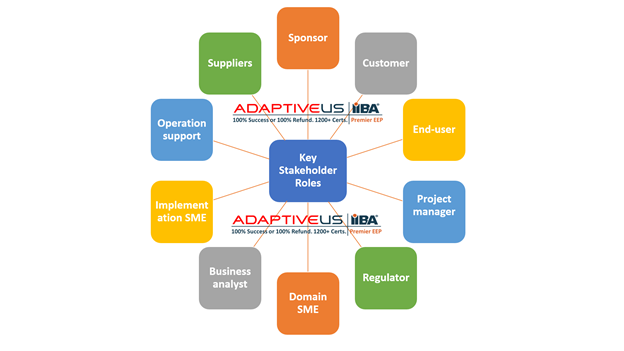Can You Name the 10 Key Stakeholder Roles in a Project?
A quick snap test for you.
Without scrolling down, write the project roles you are aware of in the next 30 seconds.
Role 1 _______________________________________
Role 2 _______________________________________
Role 3 _______________________________________
Role 4 _______________________________________
Role 5 _______________________________________
Role 6 _______________________________________
Role 7 _______________________________________
Role 8 _______________________________________
Role 9 _______________________________________
Role 10 _______________________________________
How many could you find?
Most of us who have worked in projects recognize a few roles quickly, Project Manager, Developer, Tester, etc. However, most projects have many more stakeholder roles which are important to a project's success. It isn't possible to carry out a large project with just one individual. We need multiple stakeholders playing multiple roles to make the project successful.
This blog will give us a little bit of clarity about how different roles contribute to the success of a project. But at the same time, let's remember it does not mean that a role is equal to a person. One person can play multiple roles in a project. In addition, the role may be called differently in different methods and approaches.
The top 10 Roles commonly present in most projects are depicted below:
 Let's start with the most significant role, The Sponsor.
Let's start with the most significant role, The Sponsor.
A project needs a sponsor because they are the funding provided to the project. The Sponsor obtains strategic support for the project and provides the strategic direction to the project. In addition, they are responsible for authorizing the work and scope of the project. So, from that perspective, the Sponsor adds a significant value in bringing in the capital and support to make the change successful.
The next role we have is The Customer.
In most of our projects, the products we develop are for a particular customer or a set of customers. However, customers typically utilize the product and contribute to the revenue side of the project engagement or product development. So, there can't be any revenue or business without the Customer. In addition, customers provide valuable inputs to the product features' requirements and product performance feedback. So, a lot of things come from the customers to the project team.
Then comes The End-Users.
A lot of times, we think customers and end-users are the same. But they may not be the same. For example, the one who pays for the product or service is your Customer, while the one who utilizes the product, output, or service is your End User.
End-users are a very valuable source to obtain requirements, feedback on the product's performance, and assess the risk of the project.
Next, we have The Project Manager/Product Owner in any project.
Project Managers play a vital role in guiding the project execution. They are like the captain or the leader of the team. They ensure that the project moves in the right direction and consumes the right resources. They look at the risks and issues before the project team and help those issues get resolved.
Many people say that a project manager is not needed in an agile environment or the role is not defined in such environments. However, this does not mean that the project management activities go away. In practice, project management activities are shared between the Product Owner and the Development team. Instead, the high-level project management activities are given to the product owner, who manages the product development process or the application development process. The team does task management at its level.
The difference between the Agile environment and the Waterfall Environment is how much you plan, when you plan, and to what extent. These differences are quite visible there. In Agile, the team is expected to be very motivated and capable, needing less hand-holding or less planning than a traditional waterfall project where we believe that a detailed plan is a necessary starting point.
Then, we have a role called The Regulators.
Let us keep in mind that every company, every project, every product is operating within a legal framework. The legal framework or governance framework can come from the government, your Customer, or your internal organization as well. The Regulator ensures that we don't violate any of the regulations or requirements from different sources and protects the project or product from external litigations.
Next comes The Business Analyst role.
The BA role is quite controversial. Many in the agile world espouse that the Scrum framework does not recognize a dedicated business analyst role. Again, the activities pertaining to business analysis are entrusted to the product owner and development team. Business analysts convert stakeholder needs into solution requirements. Because of the world of business, stakeholders, the technology can be very disconnected, they may speak many different languages, and the stakeholders may not provide the adequate details that the developers need. This role makes sure that the stakeholder requirements are elaborated and detailed enough. They also make sure that the change is successful.
It's not only the product that makes the transition successful. Stakeholders must be ready, and training needs to be provided. So, business analysts work like a change enabler supporting the implementation team and helping the stakeholders make the change effective.
Then, we have our Subject Matter Experts.
These are the ones who understand the business rules very well. They are an excellent stakeholder group who can review the requirements being developed as they know the business very well. So, the business analysts can capture the nuances and tell us whether the product can handle the various business scenarios that stakeholders would like the system to handle.
Next, we have The Implementation SMEs.
Implementation SMEs are solution architects, developers, and testers who help build the solution. They help to construct, implement and support the solution. Remember, the organization may realize some value only when the product is out there in the market or with the customer. That's a minimum requirement for the product to generate revenue or value for the organization.
Implementation SMEs include Testers. We may not like them because they find faults in what we do. But remember, without testing, it is impossible to deliver a high-quality solution. So, this group of stakeholders makes sure that our customers are happy with the product, and we weed out the defects before the solution is delivered to the customers.
Then, we have Operational Support.
These are the people who maintain the infrastructure and support in executing the work. Imagine a situation when the product or service is unavailable due to infrastructure unavailability. So, it's all net-zero because nobody can use the system unless the base infrastructure is available.
The final one in the top 10 list is The Suppliers.
A lot of times in our projects, we do not develop everything. It doesn't make sense because products could be available with a partner to solve our needs. However, many products and projects use components and parts from different suppliers. That way, we can speed up our development process, minimize the development cost, and ultimately provide better value to our customers.
What other roles have you come across in your projects?
You May Also Like
These Related Stories

Top Business Analyst Skills For 2025 | Free Skills Assessment

Adaptive US ECBA Study Guide - Clear and Concise



No Comments Yet
Let us know what you think